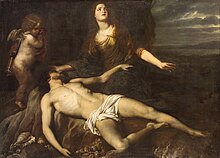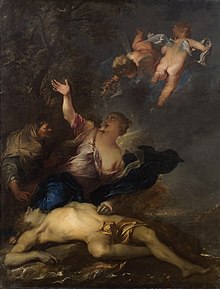Hero and Leander
This article needs additional citations for verification. (December 2017) |

Hero and Leander is the Greek myth relating the story of Hero (Ancient Greek: Ἡρώ, Hērṓ; [hɛː.rɔ̌ː]), a priestess of Aphrodite (Venus in Roman mythology) who dwelt in a tower in Sestos on the European side of the Hellespont, and Leander (Ancient Greek: Λέανδρος, Léandros), a young man from Abydos on the opposite side of the strait. Leander fell in love with Hero and would swim every night across the Hellespont to spend time with her. Hero would light a lamp at the top of her tower to guide his way.
Succumbing to Leander's soft words and to his argument that Aphrodite, as the goddess of love and sex, would scorn the worship of a virgin, Hero succumbed to his charms and they made love. Their secret love affair lasted through a warm summer. They had agreed to part during winter and resume in the spring due to the nature of the waters. One stormy winter night, Leander saw the torch at the top of Hero's tower. The strong winter wind blew out Hero's light and Leander lost his way and drowned. When Hero saw his dead body, she threw herself over the edge of the tower to her death to be with him.
Their bodies washed up on shore together in an embrace and they were buried in a lover's tomb on the shore.
Cultural references[]
This section possibly contains original research. (December 2017) |
The myth of Hero and Leander has been used extensively in literature and the arts:
- Ancient Roman coins of Abydos (Troas): Septimius Severus (coin1, coin2) Caracalla (coin)
- The Double Heroides (attributed to Ovid) treats the narrative in 18 and 19, an exchange of letters between the lovers. Leander has been unable to swim across to Hero in her tower because of bad weather; her summons to him to make the effort will prove fatal to her lover.
- Francisco Quevedo mentions Leander in "En crespa tempestad del oro undoso"
- Byzantine poet Musaeus also wrote a poem; Aldus Manutius made it one of his first publications (c. 1493) after he set up his famous printing press in Venice (his humanistic aim was to make Ancient Greek Literature available to scholars). Musaeus's poem had early translations into European languages by Bernardo Tasso (Italian), Boscán (Spanish) and Clément Marot (French). This poem was widely believed in the Renaissance to have been pre-Homeric: George Chapman reflects at the end of his completion of Marlowe's version that the dead lovers had the honour of being 'the first that ever poet sung’. Chapman's 1616 translation has the title The divine poem of Musaeus. First of all bookes. Translated according to the original, by Geo: Chapman. Staplyton, the mid-17th century translator, had read Scaliger's repudiation of this mistaken belief, but still could not resist citing Virgil's 'Musaeum ante omnes' (Aeneid VI, 666) on the title page of his translation (Virgil's reference was to an earlier Musaeus).

- Renaissance poet Christopher Marlowe began an expansive version of the narrative. His story does not get as far as Leander's nocturnal swim, and the guiding lamp that gets extinguished, but ends after the two have become lovers (Hero and Leander (poem));
- George Chapman completed Marlowe's poem after Marlowe's death; this version was often reprinted in the first half of the 17th century, with editions in 1598 (Linley); 1600 and 1606 (Flasket); 1609, 1613, 1617, 1622 (Blount); 1629 (Hawkins); and 1637 (Leake).
- Sir Walter Ralegh alludes to the story, in his 'The Ocean's Love to Cynthia', in which Hero has fallen asleep, and fails to keep alight the lamp that guides Leander on his swim (more kindly versions, like Chapman's, have her desperately struggling to keep the lamp burning).
- Shakespeare also mentions this story in the opening scene of Two Gentlemen of Verona, in a dialogue between Valentine and Proteus (the two gentlemen in the play):
- VALENTINE: And on a love-book pray for my success?
- PROTEUS: Upon some book I love I'll pray for thee.
- VALENTINE: That's on some shallow story of deep love: How young Leander cross'd the Hellespont.
- PROTEUS: That's a deep story of a deeper love: For he was more than over shoes in love.
- VALENTINE: 'Tis true; for you are over boots in love, And yet you never swum the Hellespont.
- Hero and Leander are again mentioned in The Two Gentlemen of Verona in Act III Scene I when Valentine is tutoring the Duke of Milan on how to woo the lady from Milan.
Shakespeare also alludes to the story in Much Ado About Nothing, both when Benedick states that Leander was "never so truly turned over and over as my poor self in love" and in the name of the character Hero, who, despite accusations to the contrary, remains chaste before her marriage; and in A Midsummer Night's Dream in the form of a malapropism accidentally using the names Helen and Limander in the place of Hero and Leander, as well as in Edward III (Act II, Scene II), Othello (Act III, Scene III), and Romeo and Juliet (Act II, Scene IV).
The most famous Shakespearean allusion is the debunking one by Rosalind, in Act IV scene I of As You Like It:
- "Leander, he would have lived many a fair year, though Hero had turned nun, if it had not been for a hot midsummer night; for, good youth, he went but forth to wash him in the Hellespont and being taken with the cramp was drowned and the foolish coroners of that age found it was 'Hero of Sestos.' But these are all lies: men have died from time to time and worms have eaten them, but not for love."
- Ben Jonson's play Bartholomew Fair features a puppet show of Hero and Leander in Act V, translated to London, with the Thames serving as the Hellespont between the lovers.
- It is also the subject of a novel by Milorad Pavić, Inner Side of the Wind;
- Leander is also the subject of Sonnet XXIX by Spanish poet Garcilaso de la Vega of the 16th Century;
- In the collection of short stories and essays by Lafcadio Hearn, In Ghostly Japan, the author is told the popular story of a girl that swims to her lover guided by a lantern, and he comments on the similarities with the western story: ‘—"So," I said to myself, "in the Far East, it is poor Hero that does the swimming. And what, under such circumstances, would have been the Western estimate of Leander?"’ [1]
- John Donne has an elegant Epigram summing up the story in two lines:
Both robbed of air, we both lie in one ground,
Both whom one fire had burnt, one water drowned.

- Dion Boucicault mentions Leander in his play 'The Colleen Bawn'. Corrigan refers to Hardress Cregan and his nocturnal boat rides to his secret wife as being, 'like Leander, barring the wetting'
- The myth is central to John Keats' 1817 sonnet, "On an Engraved Gem of Leander."
- Myths and Hymns, by Adam Guettel, contains a song entitled after the pair.
- Robert Schumann is said to have perceived his "In der Nacht" from Fantasiestücke as depicting the story of Hero and Leandros.
- Lord Byron references Leander in "Written After Swimming From Sestos To Abydos."; the myth of Hero and Leander inspired his own swim across the Hellespont (i.e., the Dardanelles) in May, 1810.[2] Byron also alludes to his feat, with further reference to Leander, in Don Juan, canto II, stanza 105.
- Leigh Hunt's 1819 poem Hero and Leander is based on the myth.
- Letitia Elizabeth Landon's poem Leander and Hero first appeared in 1823. Significantly, she reversed the usual order of names and used it as an example of mutual constancy.
- Franz Grillparzer's 1831 tragedy Des Meeres und der Liebe Wellen is based on the tale.
- Friedrich Schiller wrote the ballad Hero und Leander based on the tale.
- Franz Liszt's Ballade No. 2 in B Minor was most likely inspired by Schiller and other Romanticists adaptation and interest in the myth.
- Georg Friedrich Handel's 1707 solo cantata in Italian, Ero e Leandro (HWV 150), is based on the tale.
- Victor Herbert composed a tone-poem, Hero and Leander (1901).
- Alfredo Catalani composed a tone-poem, Ero e Leandro, based on the tale.
- Arrigo Boito composed an opera, Ero e Leandro, but destroyed it.
- Diana Wynne Jones's meta-fantasy novel Fire and Hemlock makes an early reference to Hero and Leander, both to foreshadow the plot and as a namesake for the heroine's alter-ego.
- Rudyard Kipling started his poem "A Song of Travel" with words: "Where's the lamp that Hero lit / Once to call Leander home?"
- Alfred Tennyson's poem "Hero to Leander" has Hero begging her lover not to leave until the morning when the sea has calmed "Thou shalt not wander hence to-night, I'll stay thee with my kisses"
- Poem XV of A.E. Housman's More Poems (1936) is devoted to the myth.[3] It describes how, "[b]y Sestos town, in Hero's tower | On Hero's heart Leander lies..."
- "The Ballad of the Oysterman", by Oliver Wendell Holmes, Sr., has a reference to the myth. The titular oysterman comments that "[he] read it in the story-book, that, for to kiss his dear, / Leander swam the Hellespont..."
- Les Misérables, by Victor Hugo, has a reference to the myth in Jean Valjean, Book V. Referring to the reaction of a duchess when she heard of the fate of her lover who died by drowning in the quicksand in Paris' sewers, Hugo comments that "Hero refuses to wash Leander's corpse."

- In Chapter XVII of "Two Years Before the Mast", Richard Henry Dana, Jr. relates an anecdote of the ship's cook, who had so bonded with a sow, "Old Bess", who had stayed aboard the vessel all the first months of the voyage, that after the sow had been taken ashore in San Diego, the cook "could hardly have been more attentive, for he actually, on several nights, after dark, when he thought he would not be seen, sculled himself ashore in a boat with a bucket of nice swill, and returned like Leander from crossing the Hellespont."
- Peter Paul Rubens painted a picture named "Hero and Leander" in 1604 based on the tale.
- Cy Twombly completed a painting in Rome in 1985 inspired by the story as told by Christopher Marlowe. The painting is entitled Hero and Leander (To Christopher Marlowe).[4]
References[]
- ^ Hearn, Lafcadio (1903). In Ghostly Japan. Little, Brown and Company.
- ^ Marchand, Leslie (1957), Byron: A Biography, I, New York: Alfred A. Knopf, pp. 238ff.
- ^ Housman, A.E. More Poems. XV.
- ^ "Hero and Leander (To Christopher Marlowe) [Rome], 1985 - Cy Twombly - WikiArt.org". www.wikiart.org.
External links[]
 Media related to Hero and Leander at Wikimedia Commons
Media related to Hero and Leander at Wikimedia Commons- Hero and Leander, full text
- Annotated text of Marlowe's poem with illustrations
- . New International Encyclopedia. 1905.
 "Leander and Hero", by L. E. L., 1823.
"Leander and Hero", by L. E. L., 1823.
- Ancient Thracian Greeks
- Greek mythological priestesses
- Mythological lovers
- Love stories